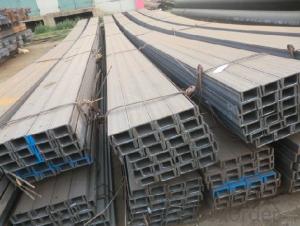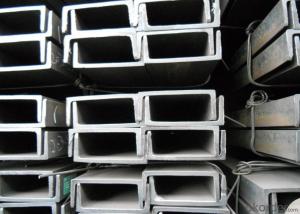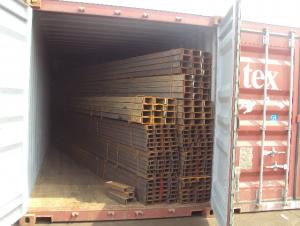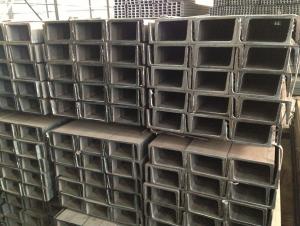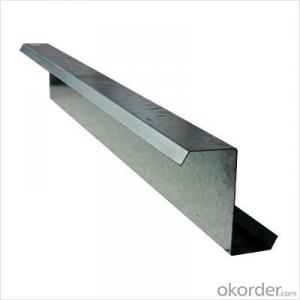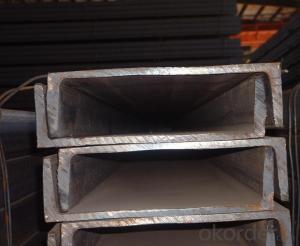GB Standard, IS Standard Steel U Channel
- Loading Port:
- Tianjin
- Payment Terms:
- TT OR LC
- Min Order Qty:
- 25 m.t
- Supply Capability:
- 20000 m.t/month
OKorder Service Pledge
OKorder Financial Service
You Might Also Like
Product Description:
OKorder is offering GB Standard, IS Standard Steel U Channelat great prices with worldwide shipping. Our supplier is a world-class manufacturer of steel, with our products utilized the world over. OKorder annually supplies products to European, North American and Asian markets. We provide quotations within 24 hours of receiving an inquiry and guarantee competitive prices. The steel u channel can be applied to construction of warehouses, workshops, sport stadiums and car parks etc. In details, the steel u channel belongs to carbon structural steel which is applied to in the field of construction and machinery. The steel u channel is usually used for arch-itechtural structure, and they could be welded in order to support or hang a vari-ety of facilities. They are also usually used in combination with I beam. Generally,the steel u channel must possess perfect welding property, riveting property and mechanical property and so on.
Product Applications:
GB Standard, IS Standard Steel U Channel are ideal for structural applications and are widely used in the construction of buildings and bridges, and the manufacturing, petrochemical, and transportation industries.
Product Advantages:
OKorder's GB Standard, IS Standard Steel U Channel are durable, strong, and resist corrosion.
Main Product Features:
· Premium quality
· Prompt delivery & seaworthy packing (30 days after receiving deposit)
· Corrosion resistance
· Can be recycled and reused
· Mill test certification
· Professional Service
· Competitive pricing
Product Specifications:
Specifications of Steel U Channel:
Standard Applied: GB Standard, EN Standard(UPN), JIS Standard
Sizes: 50mm to 300mm
Material Grade: Q235B, Q345B, S235JR, SS400, ASTM A36
As shown in the figure:
JIS U CHANNEL | Standard h | Sectional b | Dimension s | t | Mass: Kg/m |
(mm) | (mm) | (mm) | (mm) | ||
50x25 | 50 | 25 | 3.0 | 6.00 | 2.37 |
75X40 | 75 | 40 | 3.8 | 7.00 | 5.30 |
75X40 | 75 | 40 | 4.0 | 7.00 | 5.60 |
75X40 | 75 | 40 | 4.5 | 7.00 | 5.85 |
75X40 | 75 | 40 | 5.0 | 7.00 | 6.92 |
100X50 | 100 | 50 | 3.8 | 6.00 | 7.30 |
100X50 | 100 | 50 | 4.2 | 6.00 | 8.03 |
100X50 | 100 | 50 | 4.5 | 7.50 | 8.97 |
100X50 | 100 | 50 | 5.0 | 7.50 | 9.36 |
125X65 | 125 | 65 | 5.2 | 6.80 | 11.66 |
125X65 | 125 | 65 | 5.3 | 6.80 | 12.17 |
125X65 | 125 | 65 | 5.5 | 8.00 | 12.91 |
125X65 | 125 | 65 | 6.0 | 8.00 | 13.40 |
150x75 | 150 | 75 | 5.5 | 7.30 | 14.66 |
150x75 | 150 | 75 | 5.7 | 10.00 | 16.71 |
150x75 | 150 | 75 | 6.0 | 10.00 | 17.90 |
150x75 | 150 | 75 | 6.5 | 10.00 | 18.60 |
Note: We are able to supply other dimensions and sizes, which depends on the customer's requirements for the quantity.
Chemical Composition of Q235B Steel U Channel:
Alloy No | Grade | Element(%) | ||||
C | Mn | S | P | Si | ||
Q235 | B | 0.12-0.20 | 0.3-0.7 | ≦0.045 | ≦0.045 | ≦0.3 |
Physical Properties of Q235B Steel U Channel:
Grade | Yielding Strength Point(Mpa) | ||||
Q235B | Thickness(mm) | ||||
≦16 | >16-40 | >40-60 | >60-100 | ||
≧235 | ≧225 | ≧215 | ≧205 | ||
Tensile Strength(Mpa) | Elongation After Fracture(%) | ||||
Thickness(mm) | |||||
≦16 | >16-40 | >40-60 | >60-100 | ||
375-500 | ≧26 | ≧25 | ≧24 | ≧23 | |
FAQ:
Q1: Why buy Materials & Equipment from OKorder.com?
A1: All products offered byOKorder.com are carefully selected from China's most reliable manufacturing enterprises. Through its ISO certifications, OKorder.com adheres to the highest standards and a commitment to supply chain safety and customer satisfaction.
Q2: Can fit in the containers of 20fts the steel beams of 6M?
A2: No proble, we can put them into the containers in the form sideling.
Q3: The products are invoicing on theoritical weight or on actual weight?
A3: We can do it in both manners, according to the customers' request.
Images:
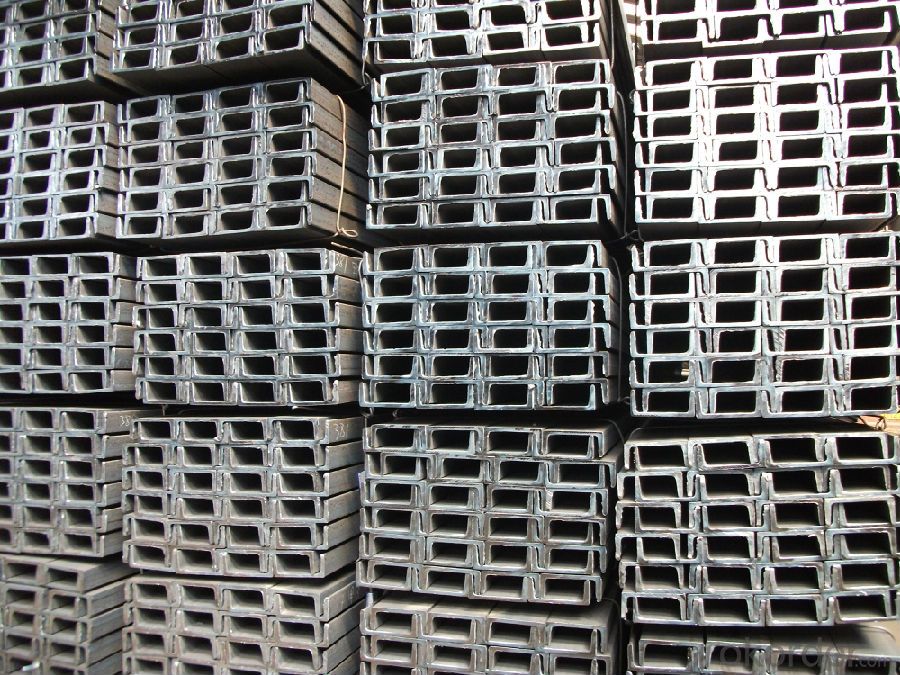
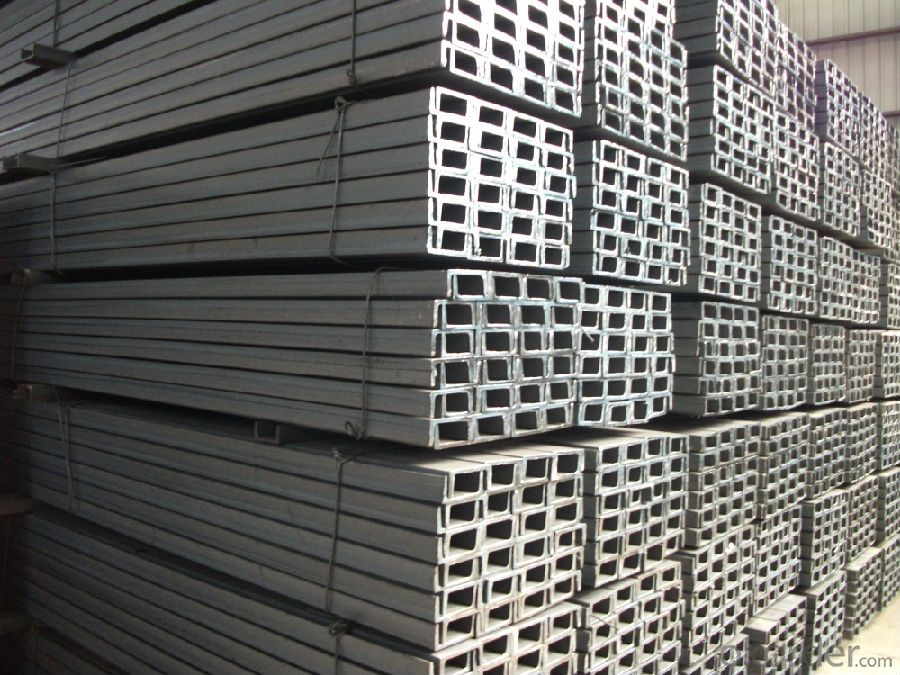
- Q:What's the width of the 22 channel wing?
- 22#a 220mm waist length 77mm legs long 7mm thick22#b 220mm waist length 79mm legs long 9mm thick
- Q:Does anyone know how to calculate the volume of channel steel?!
- Experimental method can be used: if the volume is small and convenient, the "channel" will be integrated into the tank filled with water measurement. Get ready A: a pool full of water. B: an estimate of the amount of water that will be discharged when a channel is placed in a tank full of water. C: put the "channel" into the water tank and load the water discharged by the container. D: the volume of water discharged from the metering unit. That is equal to the volume of the channel. Other liquids that do not destroy channel steel can also be used
- Q:What are the common quality control measures for steel channels?
- To ensure the overall quality and adherence to industry standards of steel channels, various common quality control measures are implemented. These measures aim to identify and address any potential defects or inconsistencies in the production process, ultimately guaranteeing that the steel channels meet the required specifications. Dimensional inspection stands as one of the most significant quality control measures for steel channels. It involves measuring the channels' dimensions to verify their compliance with the specified tolerances. Calipers, micrometers, and gauges are among the tools used for this purpose. Any deviations from the specified dimensions are detected and rectified to ensure that the channels meet the required standards. Visual inspection is another vital quality control measure. It entails visually examining the channels for surface defects, such as scratches, cracks, or dents. By conducting visual inspections, manufacturers can ensure that the channels possess a smooth and uniform surface, devoid of any imperfections that could compromise their structural integrity or appearance. Material testing also plays a crucial role in quality control. It encompasses various tests conducted to determine the chemical composition and mechanical properties of the steel used in the channels. Tensile strength, yield strength, elongation, and hardness tests are examples of such tests. Material testing guarantees that the steel channels exhibit the desired strength and durability. Welding inspection is yet another prevalent quality control measure for steel channels. It involves scrutinizing the welded joints for any defects, such as incomplete penetration, porosity, or cracks. Welding inspection ensures that the channels possess strong and reliable welds, which are essential for their structural stability. Lastly, packaging and labeling inspection is carried out to verify that the steel channels are packaged, protected, and labeled appropriately. This includes confirming that the channels are bundled, secured, and shielded from damage during transportation. Additionally, the labels on the packaging should accurately depict the specifications, grade, quantity, and other pertinent information. Overall, these quality control measures play a critical role in ensuring that steel channels meet the required standards and specifications. Through their implementation, manufacturers can guarantee that their products exhibit high quality, reliability, and suitability for their intended applications.
- Q:Can steel channels be used in DIY projects?
- Indeed, steel channels have the potential to be employed in do-it-yourself endeavors. Their versatility renders them suitable for a diverse array of uses, including the assembly of frames, supports, shelving, and even furniture. By virtue of their strength and durability, they confer structural stability upon your own creations. Furthermore, steel channels are accessible in a multitude of sizes and shapes, affording you the opportunity to procure an ideal match for your unique project specifications. Whether your undertaking is a modest DIY venture or a more substantial construction endeavor, steel channels have the capacity to function as a valuable asset within your inventory of materials.
- Q:Are steel channels suitable for earthquake-prone regions?
- Indeed, steel channels are well-suited for regions prone to earthquakes. Renowned for their strength and ductility, steel is a favored material for constructing earthquake-resistant buildings. Specifically, steel channels offer numerous advantages in seismic areas. Firstly, steel channels possess exceptional load-bearing capabilities, enabling them to withstand the forces produced during an earthquake. The shape of these channels provides structural rigidity and stability, minimizing the risk of collapse or damage. Moreover, steel's inherent flexibility allows it to absorb and dissipate seismic energy, reducing the impact on the overall structure. Furthermore, steel channels can be easily tailored and fabricated to meet specific building requirements. This adaptability empowers engineers to design structures with appropriate seismic resistance, ensuring their ability to endure anticipated ground motion. The dimensional accuracy and uniformity of steel channels also contribute to enhanced construction quality and performance during earthquakes. Another advantage of steel channels lies in their fire resistance. Unlike materials such as wood or concrete, steel does not burn or contribute to the spread of fire. This characteristic makes steel channels a safer choice for earthquake-prone regions, where fires often result from ruptured gas lines or electrical failures during seismic events. Additionally, steel's durability and resistance to corrosion make it an ideal choice for long-term use in earthquake-prone areas. Steel channels require minimal maintenance and have a longer lifespan compared to alternative materials, guaranteeing the long-lasting safety and stability of structures. In conclusion, the strength, ductility, load-bearing capabilities, adaptability, fire resistance, and durability of steel channels make them highly suitable for earthquake-prone regions. These qualities render steel channels a dependable option for constructing earthquake-resistant buildings capable of withstanding the forces generated by seismic events.
- Q:What are the different types of surface treatments for steel channels in marine applications?
- There are several different types of surface treatments for steel channels used in marine applications. These treatments are designed to enhance the durability and corrosion resistance of the steel in harsh marine environments. One common surface treatment is hot-dip galvanizing. In this process, the steel channel is dipped into a bath of molten zinc, which forms a protective coating on the surface. This coating acts as a barrier against corrosion, protecting the steel from the corrosive effects of saltwater and other marine elements. Another option is epoxy coating. This involves applying a layer of epoxy paint to the surface of the steel channel. The epoxy creates a protective barrier, preventing water and oxygen from reaching the steel and causing corrosion. Epoxy coatings can be particularly effective in marine environments where there is a high risk of abrasion or impact. In addition to galvanizing and epoxy coating, there are also other surface treatments available for steel channels in marine applications. These include metalizing, which involves spraying molten metal onto the surface of the steel to provide a protective coating, and electroplating, which involves depositing a layer of metal onto the surface of the steel using an electric current. Furthermore, some manufacturers offer specialized marine coatings that are specifically formulated to withstand the unique challenges of marine environments. These coatings may contain additives or compounds that provide enhanced corrosion resistance and durability. Ultimately, the choice of surface treatment for steel channels in marine applications will depend on factors such as the specific environment, the level of corrosion resistance required, and the budget. It is important to consult with a corrosion specialist or an engineer to determine the most suitable surface treatment for a particular marine application.
- Q:How do steel channels perform under earthquake loads?
- Steel channels exhibit excellent performance when subjected to earthquake loads due to their high strength and ductility. The structural design of steel channels effectively enables them to resist the dynamic forces and vibrations caused by earthquakes. The unique combination of their shape and material properties allows steel channels to efficiently distribute and dissipate seismic energy, minimizing the potential for structural damage. Their inherent rigidity and stiffness enable them to withstand lateral loads and resist bending, torsion, and shear forces induced by earthquakes. Furthermore, steel channels can be further enhanced through the implementation of various seismic design strategies, such as additional bracing and connections. These enhancements significantly improve the performance of steel channels under earthquake loads, enhancing their structural stability and resilience during seismic events. Moreover, the versatility and adaptability of steel channels make them a popular choice for earthquake-resistant buildings and structures. They can be easily modified and reinforced to meet specific seismic design requirements, ensuring the overall safety and reliability of the structure. However, it is important to note that the performance of steel channels under earthquake loads is influenced by factors such as their size, quality, and installation. Therefore, proper design, construction, and maintenance practices are crucial to ensure the optimal performance of steel channels in seismic conditions. Seeking guidance from structural engineers and adhering to relevant building codes and regulations is essential to ensure the appropriate design and installation of steel channels in earthquake-prone areas.
- Q:Can steel channels be used in multi-story buildings?
- Yes, steel channels can be used in multi-story buildings. Steel channels, also known as C-channels or structural channels, are commonly used in construction for their strength and durability. They provide structural support and are often used as framing members in various applications, including multi-story buildings. Steel channels are lightweight yet strong, making them suitable for multi-story buildings where weight is a crucial factor. They can be easily fabricated and installed, reducing construction time and costs. Additionally, steel channels offer excellent resistance to fire, corrosion, and other environmental factors, ensuring the long-term stability and safety of the building. In multi-story buildings, steel channels can be used as beams, columns, or bracing elements to distribute the load and provide stability. They can support the weight of floors, walls, and roofs, while also withstanding dynamic forces such as wind and seismic loads. With proper engineering and design considerations, steel channels can efficiently handle the vertical and horizontal loads that occur in multi-story buildings. Furthermore, steel channels can be integrated with other structural systems, such as steel frames or reinforced concrete, to create a robust and flexible building structure. Their versatility allows for various design possibilities, accommodating different architectural styles and functional requirements. In conclusion, steel channels are a suitable choice for multi-story buildings due to their strength, durability, and versatility. They provide structural support, resist environmental factors, and can be easily integrated into the building's framework.
- Q:What are the maintenance requirements for steel channels?
- The maintenance requirements for steel channels primarily involve regular cleaning and inspection to ensure their structural integrity and prevent corrosion. Cleaning should be done using a mild soap and water solution or a non-abrasive cleaner to remove any dirt, dust, or debris that may accumulate on the surface of the channels. It is important to avoid using harsh chemicals or abrasive cleaners as they can damage the protective coatings on the steel. Regular inspection is crucial to identify any signs of wear, damage, or rust formation. Any visible signs of rust should be addressed immediately by removing the rust using a wire brush and applying a rust-inhibiting primer and paint to protect the steel from further corrosion. In areas with high humidity or exposure to saltwater or chemicals, more frequent inspections and maintenance may be required. Additionally, it is important to keep the steel channels clear of any obstructions or debris that could impede their functionality or compromise their structural integrity. Regular checks should be made to ensure that the channels are properly aligned and securely fastened to their support structure. Proper maintenance practices for steel channels will extend their lifespan and ensure they continue to perform their intended function effectively. It is also recommended to follow any manufacturer-specific maintenance guidelines or consult with a professional for specific requirements based on the application and environment in which the steel channels are installed.
- Q:What are the methods and the price of building the floor?
- Determine the area: according to the force of the wall and load-bearing situation, you can clear the general scope of the attic. There is no need to blindly pursue the area.There are some higher floors, or duplex rooms with a hollow living room friends, perhaps they will have to build attic needs, and build attic and involves some deeper knowledge
1. Manufacturer Overview |
|
|---|---|
| Location | |
| Year Established | |
| Annual Output Value | |
| Main Markets | |
| Company Certifications | |
2. Manufacturer Certificates |
|
|---|---|
| a) Certification Name | |
| Range | |
| Reference | |
| Validity Period | |
3. Manufacturer Capability |
|
|---|---|
| a)Trade Capacity | |
| Nearest Port | |
| Export Percentage | |
| No.of Employees in Trade Department | |
| Language Spoken: | |
| b)Factory Information | |
| Factory Size: | |
| No. of Production Lines | |
| Contract Manufacturing | |
| Product Price Range | |
Send your message to us
GB Standard, IS Standard Steel U Channel
- Loading Port:
- Tianjin
- Payment Terms:
- TT OR LC
- Min Order Qty:
- 25 m.t
- Supply Capability:
- 20000 m.t/month
OKorder Service Pledge
OKorder Financial Service
Similar products
New products
Hot products
Hot Searches
Related keywords
